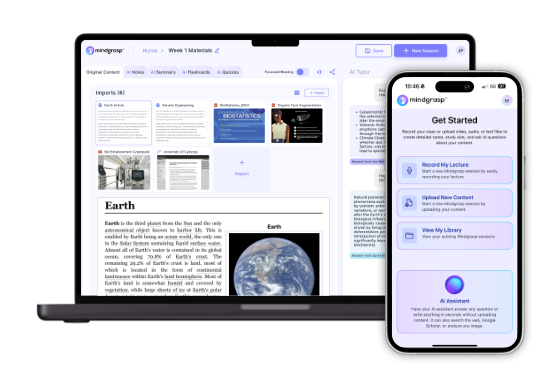
To cram for statistics, we need to be strategic.
First, identify high-impact topics like probability and hypothesis testing. Create a formula reference sheet and use flashcards for key concepts. Don't just reread—solve practice problems and explain concepts aloud.
Draw diagrams for complex processes, and prioritize sleep over all-nighters. Break study sessions into chunks with short breaks.
The techniques below will transform your last-minute studying from panic to productivity.
Whether it’s statistics or math related, our AI study guide generator helps you prep faster by converting slides into actionable notes and quizzes.
Why cramming for statistics feels harder than other classes
While we've all tried to pull an all-nighter before a big test, statistics presents unique challenges that make cramming particularly ineffective. Unlike subjects where you can memorize facts or dates, statistics concepts build on each other - miss one foundational idea and the whole structure crumbles!
When we cram, we're just memorizing formulas without understanding how to apply them. Statistics isn't about rote learning - it's about interpretation and reasoning. Those practice problems that seem so tedious? They're actually essential for developing the analytical skills you need.
The real-world applications in statistics require more than just last-minute strategies in place. We need time to process how data tells a story. That's why so many of us feel lost when we try to cram - our brains need that processing time!
Boost Your GPA Faster with Mindgrasp
Instantly turn your class notes into smart summaries, flashcards, and quizzes—study less, learn more, and ace your exams.
Try it FreeStep 1: Determine what to study (Prioritize high-impact topics)
Now that we recognize why cramming isn't ideal, let's make the best of our limited time! When facing a statistics exam with only hours to prepare, we need to prioritize ruthlessly.
Start by checking your syllabus to identify the important concepts your professor emphasized. Topics like probability, hypothesis testing, and regression analysis typically carry the most weight.
Next, review past exams or practice questions to spot patterns – what keeps showing up again and again?
Create a quick-reference sheet with must-know formulas and definitions for high-impact topics. Remember, understanding the "why" behind statistical methods is more valuable than memorizing every detail.
If you're torn between topics, tackle the hardest ones first, but don't neglect the basics – they're often worth easy points!
Step 2: Gather your statistics materials and make a quick plan
The mad scramble to gather your statistics materials might feel overwhelming, but don't panic! Start by collecting everything you need in one place—textbooks, lecture notes, handouts, and past assignments.
Then organize them by topic so you can quickly find what you need.
Next, create a simple study plan that focuses on the key concepts from your syllabus.
We recommend:
- Dividing your available time between topics based on importance
- Allocating extra time for areas where you're less confident
- Incorporating practice questions throughout (not just at the end!)
- Building in short breaks to keep your mind fresh
Step 3: Use active recall to study statistics (Don’t just re-read)
With your study plan ready, let's talk about how you'll actually absorb all that statistical information. Simply re-reading your notes won't cut it—your brain needs to work actively with the material.
Try these active recall approaches:
- Create flashcards with statistical concepts on one side and definitions on the other
- Challenge yourself to write formulas from memory before checking if you're right
- Tackle practice problems without peeking at solutions first (this is essential!)
- Join a study group where you can quiz each other on key concepts
When we actively test ourselves, our brains form stronger connections to the material.
Even if you're cramming, spending an hour actively recalling information beats three hours of passive re-reading. Your brain remembers what it works for!
Step 4: Break down complex statistics processes with diagrams
Because complex statistical processes can feel overwhelming, breaking them down visually is a game-changer for cramming. We've found that visualization transforms abstract statistical methods into manageable chunks that stick in your memory.
Try these diagram approaches:
- Draw flowcharts to map out hypothesis testing steps
- Use Venn diagrams to clarify probability concepts
- Create box plots to understand data distributions
- Sketch scatter plots to visualize correlations
- Make mind maps connecting related statistical concepts
When cramming, these visual tools help you see the big picture of data analysis while reinforcing the details.
Don't worry about artistic talent – even simple diagrams can dramatically improve your understanding! The act of creating them forces you to process information differently, which is exactly what you need when time's running out before your stats exam.
Step 5: Leverage AI study tools like Mindgrasp AI for statistics
Today's AI tools can revolutionize how you prepare for your statistics exam—especially when time's running short.
We've found that platforms like Mindgrasp AI can be your secret weapon when cramming for statistics. This clever tool quickly summarizes your textbooks and lecture notes, letting you focus on what really matters.
Try Mindgrasp for Free!
Experience an easier, faster way to boost your GPA. Sign up now to try Mindgrasp AI for free and see how AI-powered learning transforms your study routine.
Try it FreeStruggling with probability distributions or hypothesis testing? Just ask Mindgrasp to explain it in simpler terms!
What we love most is how it creates custom practice problems based on the exact statistics concepts you're studying. This targeted approach means you'll use your limited study resources more efficiently.
Plus, the user-friendly interface makes jumping between topics super easy—no more wasting precious time flipping through textbook pages when you're in crunch mode!
Step 6: Memorize key terms and definitions with flashcards & mnemonics
Statistics terminology can overwhelm even the best students, but flashcards and mnemonics are your secret weapons for last-minute memorization.
We've found that creating flashcards with key terms on one side and definitions on the other triggers active recall—forcing your brain to work harder, which actually improves retention!
Try these quick approaches:
- Create colorful flashcards with simple diagrams (a bell curve for normal distribution)
- Review in short, spaced sessions rather than one marathon cram session
- Develop memorable mnemonics (PEMDAS for operation order, or "SAD" for Sum of Absolute Deviations)
- Quiz yourself repeatedly, not just reading the cards
Step 7: Practice with questions and problems
While knowing theories and definitions is essential, nothing prepares you better for a statistics exam than rolling up your sleeves and tackling actual problems. We recommend working through as many practice problems as possible from your textbook, study guides, and online resources.
Focus especially on:
- Problems similar to those on previous exams (ask classmates for old exam questions!)
- Areas of basic statistics where you feel shaky
- Questions that combine multiple concepts
When you get something wrong—don't panic! That's actually great news. Each mistake is showing you exactly what to review before the real test.
Try timing yourself too, so you're not caught off-guard by the pressure of the clock on exam day.
Step 8: Take short breaks and look after yourself
Your brain needs three distinct breaks when cramming for statistics: mental rests, physical movement, and proper nourishment.
We recommend breaking your study sessions into smaller chunks of 25-30 minutes, followed by a 5-minute breather. This rhythm helps you stay sharp enough to answer questions accurately!
Don't forget to take care of your body too. Stand up, stretch, or take a quick walk during breaks — your brain loves that extra oxygen!
Keep water nearby (dehydration kills concentration) and munch on brain-friendly snacks like nuts or fruit.
Most importantly, don't sacrifice sleep. Getting enough sleep (7-9 hours) is when your brain actually processes all those formulas and concepts you've been studying.
No amount of cramming beats a well-rested mind!
Cramming for statistics in 1 Day, 3 Days, or 1 Week
Let's look at how to handle your statistics cramming based on the time you have left.
With one week remaining, we can create a daily study schedule that tackles specific concepts each day, incorporates practice exams, and includes study breaks to prevent burnout.
If you've got just three days, you'll need to focus on high-value topics, solve targeted practice problems, and review your mistakes promptly to maximize learning in your limited time.
For those in a 24-hour crunch, your best bet is creating a quick formula sheet, using flashcards for key concepts, and prioritizing the topics you're least confident about.
Cramming for statistics with one week left
When you have a full week before your statistics exam, you're in a sweet spot—not quite comfortable, but definitely not doomed!
Let's use this time wisely with some proven strategies.
First, grab your syllabus and highlight the most important concepts that appear frequently on exams. This targeted approach helps you avoid wasting time on minor details.
We recommend breaking your week into chunks:
- Days 1-2: Review core formulas and definitions
- Days 3-4: Work through practice problems
- Days 5-6: Take mock exams under timed conditions
- Day 7: Light review of trouble spots
Don't forget to create flashcards for key formulas—they're perfect for quick reviews between longer study sessions.
With a full week, you've got time to build both understanding and confidence!
Cramming for statistics with three days left
Three days before your statistics exam presents a challenging but manageable timeline if you approach it strategically.
We need to make the most of this limited time—no room for panic!
Start by creating a quick schedule that divides your remaining 72 hours into focused study blocks. You don't have much time to waste, so prioritize topics you're struggling with.
Try these quick tactics:
- Grab your notes and write down formulas from memory
- Work through practice problems together with classmates
- Make simple flashcards for key definitions
- Review one concept at a time, then test yourself
Cramming for statistics with one day left (24 hours)
So you've got just 24 hours until your statistics exam? Don't panic—we can make this work!
First, create a structured study schedule for these final hours, breaking your day into manageable chunks with short breaks.
Start by reviewing key formulas that appear frequently on exams—probability distributions, confidence intervals, and hypothesis testing should be your priority.
Make a condensed formula sheet for quick reference.
Next, tackle practice problems across different topics, especially ones you find challenging.
Ask yourself questions as you work: "What concept does this test?" and "What formula applies here?"
Try explaining concepts aloud (yes, to yourself—it works!). This active recall helps cement your understanding.
Remember to eat well and get some sleep tonight—your brain needs fuel and rest to perform tomorrow!
Common mistakes to avoid when cramming and how to fix them
Despite our best intentions, last-minute studying often leads us down a path of common errors that can sabotage our statistics exam performance. When cramming, we tend to fall into passive review traps—simply re-reading notes without engaging our brains.
Instead, tackle practice problems that force you to apply concepts actively.
Don't make these common mistakes:
- Memorizing formulas without understanding their purpose
- Neglecting your weakest areas (address them first!)
- Staying up all night (your brain needs sleep to function)
- Failing to simulate exam conditions (time yourself!)
Final Takeaways on statistics cram studying
When you've got limited time before your stats exam, focusing on what truly matters can make all the difference.
Don't go overboard with excessive materials—stick to formulas, definitions, and practice problems that frequently appear on exams.
Make sure you're using the right strategies: create that formula sheet, practice active recall, and get enough sleep!
Online resources like practice quizzes and tutorial videos can fill knowledge gaps quickly, but be selective about what you use.
Download Mindgrasp from the App Store
Access Mindgrasp at your desk for in-depth research and writing projects, or use the mobile version to easily access your content on-the-go or record live lectures.
Download the iOS App
